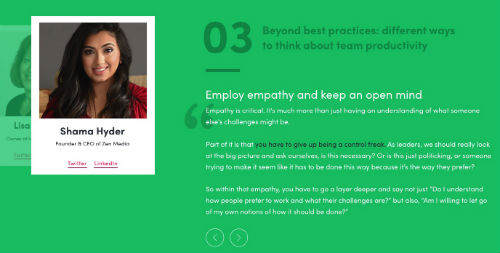Virtually every marketing tactic is under evaluation right now as B2B marketing departments react to the domino effect of changes in consumer spending during the pandemic. Many B2C marketers are putting a pause on their influencer marketing investments as the world of travel, hospitality, retail, sports and entertainment have changed dramatically.
In the business to business world, things have changed as well but not anywhere near as significantly and not always at the expense of lowered marketing budgets. The trend in B2B is digital and self serve from virtual events and prospect engagement to buyers now conducting the majority of their research and interactions on their own before making purchase decisions.
Influences on those purchase decisions are not coming from field marketing, trade conferences or experiential events. Influences on B2B buyer behavior is decidedly online and digital, including through education and recommendations from industry experts. Smart B2B marketers realize this and have continued to engage with B2B influencers to co-create content of value to digitally savvy customers.

For example, take this new Future of Agile Teamwork resource from Monday.com (client) featuring teamwork and productivity insights from Carla Johnson, Shama Hyder, Deb Lee, Jay Acunzo and eight more marketing and design influencers.
The smart marketing team at Monday.com is more than capable of putting out useful advice on productivity for creative and marketing teams on their own (and they do), but they also realize their customers pay closer attention to individuals than brands. Trusted experts have the attention of buyers who can then be reached, engaged and inspired to take action a lot more effectively during good times or a pandemic than through the brand voice alone.
There’s a certain set of costs to creating such a resource, including strategy development and planning, influencer identification and engagement, content development, design, development, promotion, influencer activation for sharing and overall campaign management and measurement.
For some B2B marketers, there’s a temptation to think of influencers as an add-on to brand content and therefore, only engage influencers when they need them for their planned quarterly campaigns. The issue with this approach to influencer engagement is a lack of engagement.
The thing is, Influencer Marketing is a relationship business. If the only time someone reaches out to you is when they want something from you, how motivating of a relationship is that? I’ll answer that – it’s not.
The marketing team at Monday.com understand this and are investing in more than one-off campaigns and influencer activations. Every marketing department must be accountable to performance and investing in relationships with the voices of industry experts that your customers trust can create an excellent return for everyone involved: customers, influencers and the brand. That ongoing investment in time, effort and resources to develop, maintain and activate relationships is what Always On Influencer Marketing is about.
We’ve highlighted other examples of B2B brands implementing ongoing, always on influencer marketing programs before, but to help B2B marketers better understand why Always On influencer marketing delivers more efficient and effective marketing performance, here are the top 5 reasons why always on costs less and delivers better ROI than one off influencer content campaigns.
1. Pay to Play Doesn’t Always Pay Off
One off influencer engagement tends to be a transactional experience. That’s fine if the brand doesn’t intend to work with the influencer again or if they always expect to pay a certain fee for that influencer’s participation. Some B2B influencer programs are set up to be fully paid programs. Many successful influencer programs have strength in numbers of influencers involved. While there is a certain increase in accountability for the influencer’s performance when they are paid, it can get very expensive pretty quickly once you start adding well known influencers.
A more organic relationship between brand and influencer can take a little more time up front, but doesn’t cost anywhere near as much as a one-off, paid influencer campaign. An ongoing relationship-based approach also means more micro-activations in between campaigns which can extend the value and performance of a campaign without any additional costs.
2. Old Friends Know the Brand Ropes
With influencer marketing and content collaborations, there are aspects that require significantly more ramp up time with new influencers than with those who already know your brand. New influencers need to be researched, vetted, reviewed and approved, recruited and engaged to provide great content. After all that, they need to be persuaded to promote the content as well. Doing all of this with an intermittent brand influencer requires a lot more hand holding and brand education than with influencers whom the brand works with on an ongoing basis or at least engages with some regularity. That additional discovery and management time can add substantial cost to campaigns.
3. Return on Relationships
One of the great benefits of having a trusted industry expert collaborate with your brand is the inevitable advocacy that can occur during their conversations and engagement with their networks. Word of mouth is still the most powerful form of advertising and you don’t really get that kind of invested and proactive advocacy with influencers who are only engaged for one off projects and nothing in-between. Influencer management does require a well organized effort, but not a very expensive effort. The return on that investment in time to engage on social channels, email occasionally, do a virtual happy hour and recognize in brand content is far, far greater than the cost.
4. Repurpose with Purpose
Many B2B marketers want to know what do you do when you are implementing and Always On influencer marketing program? With one off campaigns, when the project is done, it’s done.
But with always on, one of the most efficient tactics marketers can do to optimize and maximize the value of influencer contributions while also creating positive signals for the influencers is to repurpose content. The key to repurposing with the purpose of achieving value at multiple levels is in the planning. When influencer contributions are captured, they can be categorized by topic and archived in a spreadsheet or database. Then when a newsletter, blog post, social channel, presentation, contributed article, ebook, infographic, explainer video or any other kind of content needs that perfect quote from an industry expert to give credibility to the brand, you have it right there. Repurposing influencer content like this as part of regular brand content creates value for the brand through credibility, it creates exposure for the influencer which they will appreciate and it provides useful and inspiring content to customers. Everybody wins!
5. Advocacy at Scale
After working with influencers over the past 8 years or so, many have become friends. Friends take a genuine interest in their mutual success and when a B2B brand can effectively develop real relationships with industry experts over time, those connections can become an incredible source of brand or product advocacy in the marketplace.
You might pay an influencer for certain types of work from time to time and engage then organically for others, but it’s the relationship over time with their point of contacts at the brand and/or agency and especially with each other through a community that develops the kind of mutual trust, respect and admiration that manifests into recommendations that reach people that are virtually impossible to reach otherwise.
To do this with a community of influencers is truly a brand accomplishment and one of the best examples I’ve seen is the AdobeInsiders influencer community. Rani Mani and Monica Grant do an incredible job fostering a community of influencers that can’t wait to advocate for Adobe and the values they share.

In our research for the 2020 State of B2B Influencer Marketing Report, we found that those B2B brands that were most successful, shared certain characteristics. One of those traits was the tendency to practice Always On influencer engagement. In fact, 20% of marketers surveyed implement always on programs and 56% implement a combination of campaigns and ongoing influencer engagement.
There is confidence in the value of creating relationships with industry influencers and working to engage them over time. Given that the most successful B2B brands at influencer marketing also use always on influencer engagement hints that there’s also greater marketing ROI in those relationships.
If you would like to get access to the 2020 State of B2B Influencer Marketing Report, you can sign up here.
The post Always On Influence: Costs Less and Better ROI – Here’s Why appeared first on Online Marketing Blog – TopRank®.
